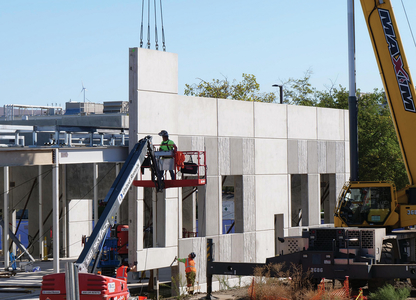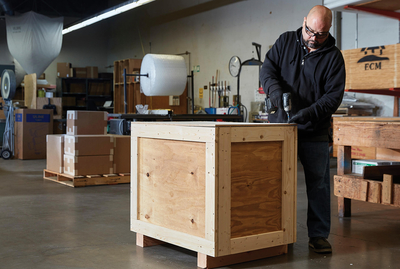Conducting safe, secure, and environmentally sound operations and modernizing the Laboratory’s infrastructure to meet evolving mission needs
Committed to the highest level of operational performance, LLNL implements best practices in environment, safety, and health (ES&H), and security. Management systems support continuous improvement in work practices. Prudent risk management coupled with active measures to prevent accidents ensures the safety of employees and the public. Investments are targeted to modernize the Laboratory’s infrastructure and continually improve operations.
Streamlining Operations
LLNL is streamlining operations and providing leadership in responding to NNSA’s Enhanced Mission Delivery Initiative (EMDI). Established to make the nuclear security enterprise (NSE) more agile and responsive to the many challenges it faces, the EMDI focuses on reinvigorating NNSA’s working relationship with its national laboratories and production sites. For example, working closely with the Livermore Field Office, the Laboratory has successfully piloted the use of Cal/OSHA regulations for construction projects as an acceptable substitute for 10 CFR 851, DOE’s worker safety and health regulation. Use of California standards has permitted more local/regional construction businesses to bid on and execute projects. This change reduces confusion, lowers cost, and eliminates inefficiencies associated with subcontractor compliance with an unfamiliar regulatory framework while maintaining ES&H standards consistent with 10 CFR 851. The Laboratory and NNSA are also exploring opportunities for modifying Lawrence Livermore National Security’s management and operating contract to increase efficiency through effective risk-based decision making and management.
EMDI leadership is exemplified in LLNL’s partnering with all sites across the NSE to identify opportunities for improvement and use pilot projects to demonstrate that they should be standardized as best practices. In particular, the W80-4 and W87-1 modernization programs are introducing new approaches to project management as well as design, manufacturing, and certification through many pilot projects (see Strategic Deterrence).
Environmental Management and Sustainment
The 2022 Site Annual Environmental Report (issued in October 2023) documents LLNL’s compliance with environmental standards and monitoring results. This year, Livermore became the first in the NNSA complex to successfully implement standards from the American National Standards Institute for clearance of radioactive materials. LLNL began removing soils from Site 300 and demolition wastes from other projects. The Laboratory also achieved the best possible score from the California Department of Toxic Substance Control for having no Class 1 violations in the past 10 years. In addition, LLNL earned an NNSA Green Fleet Award for efforts targeting government fleet conversion to zero emissions vehicles. Sustainability pursuits also included an expanded site-wide recycling and composting program. In FY 2023, eight facilities were under construction or in the design phase that meet the federal Guiding Principles for Sustainable Buildings.
Mission Enablement
In FY 2023, operations at the Laboratory were well managed, with significant accomplishments and focused efforts to implement EMDI recommendations. LLNL conducted efficient, effective business operations and financial management. Individual and team efforts achieved many notable successes in ES&H, information technology management, legal services, and nuclear operations. Within the Laboratory’s business services area, the shipping and distribution team processed a record-breaking 201,145 packages in FY 2023. In supply chain management, procurements surpassed $1.25 billion, which exceeded the previous year’s record $1.1 billion. Small business spending topped $525 million (see Workforce Recognition). In addition, LLNL worked with NNSA’s Livermore Field Office to identify areas in its purchasing system where the risk tolerance could be reasonably raised to enable the Laboratory to be more agile and meet the increasing demands of its mission.
Infrastructure Management
An enormous amount of activity is ongoing to meet LLNL staff’s needs for modernized facilities and infrastructure in support of continuing mission success. In FY 2023, the Laboratory’s project management office supported the completion of more than 120 construction projects, valued in excess of $200 million (see Managing the Future). New project management tools and systems are enabling greater efficiency and streamlined project delivery. In addition, NNSA’s Standardized Acquisition and Recapitalization (STAR) Initiative—launched in 2019 with pilot projects at LLNL—is reducing costs and accelerating construction of small office and light laboratory facilities by developing common standards and common scalable designs that can be used across sites. Construction is ongoing for six new STAR buildings valued at $100 million that will provide the Laboratory with about 124,000 square-feet of new laboratory and office space and nearly 500 new offices.
In addition to new construction, the Laboratory is demolishing outdated facilities, refurbishing facilities where cost effective, and attending to a maintenance backlog. Large-facility decontamination and demolition jobs over the last several years have greatly increased the volume of radioactive waste disposed of each year. More than 2,200 cubic meters (about 10,000 drum equivalents) of waste were disposed of in FY 2023, including a successful 70-drum transuranic waste shipment to the DOE Waste Isolation Pilot Plant at Carlsbad, New Mexico.
Winter Storm Emergency Operations
In January 2023, the new Emergency Operations Center (EOC) was activated for the first time. The extended winter rainstorms caused a curtailment of operations at remote Site 300 due to road closures. About a foot of rain fell over an area that commonly goes without precipitation for most of year. The EOC collected a considerable amount of data to keep information for employees up-to-date regarding current conditions and closures. Site 300 employees worked at the main site temporarily. Security officers, firefighters, and maintenance personnel kept a constant presence at the site—one team for a stretch of nearly 36 hours. LLNL maintenance crews responded to 143 storm-related work requests. The storms brought down 17 trees over a two-week period. ES&H teams focused on making sure storm water runover from construction and industrial areas did not reach local streams. The workload was heavy for LLNL operations, but damage was minimal and construction crews were able to recover schedules after the storms passed.







